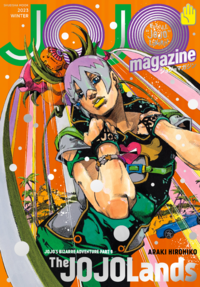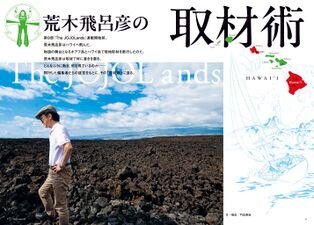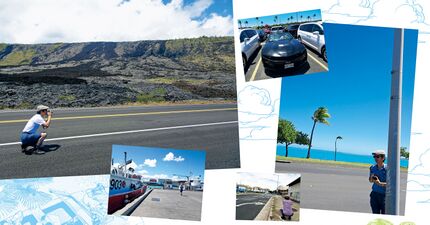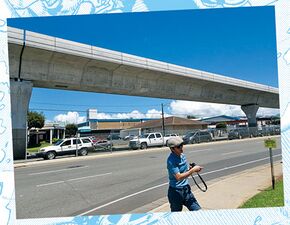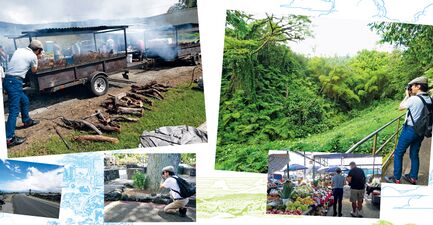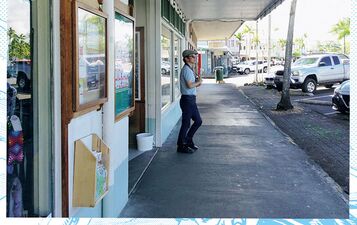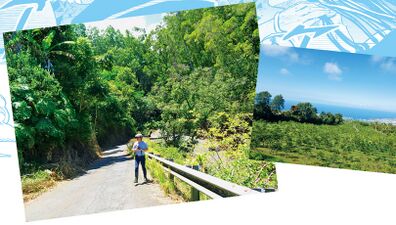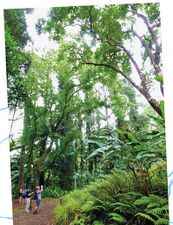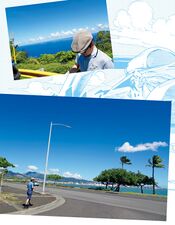Hirohiko Araki's Research Techniques (December 2023)
Interview Archive
A research report of when Araki visited Hawaii, before the start of The JOJOLands. It was published in the Winter 2023 issue of JOJO magazine, released on December 19, 2023.
Interview
Before the serialization of Part 9: The JOJOLands, Hirohiko Araki flew to Hawaii. He boldly conducted on-site research on Oahu Island and Hawaii Island (aka. "the Big Island"), which are the settings for the story. What does Araki emphasize during his research, how does he act, and what does he gain? Based on the testimonies of the editors who accompanied him, this article delves into his "research techniques."
Written and composed by Kadokura Shima.
Araki has said that he always makes it a priority to personally conduct his own research. He picked out places he wanted to visit, including the school Jodio Joestar attends and the villa where Rohan Kishibe stays. Based on those choices, Araki and the editorial department discussed and organized an itinerary that covered both Oahu and Hawaii Island.
The research took place around the time when the rough draft for The JOJOLands was formed. The editor who accompanied him said, "Araki-sensei always writes the framework of the story in a sketchbook and explains it to us during meetings. But this time, we went on the research trip when the framework had somewhat solidified." (The text inside quotes are the editor's comments.)
In his book Hirohiko Araki's Manga Techniques, Araki says, "When you go to a location, you can clearly understand which parts you need, and you may even get unexpected ideas on the spot."
"I think the things we saw and heard on location fleshed out the 'bones' of the story... you could say it became more concrete."
The protagonist of Jodio was beginning to take shape within Araki's mind during the latter part of JoJolion's serialization. But as expected, the land of Hawaii and the people living there were instrumental to the creation of Jodio’s character. He also directly heard personal stories from locals, such as taxi drivers, which helped expand the image of Jodio. However, the foundation of Araki’s research is to carefully observe people’s actions. He closely observed how young people dressed (and it’s said that he "remembers what he saw very well").
"True observation... it doesn't mean looking around, it means looking around carefully... to not just listen, but to listen well."[1] Following this line from Jotaro Kujo, Araki’s constant "watching" is probably what fleshes out his characters and stories, increasing their realism.
In general, Araki takes all the photographs himself.
This time, Araki said, "I want to see what kind of plants grow over there (in Hawaii)," and he stayed at the botanical garden for a long time, capturing many plants with his camera.
Araki often captures a wide picture while also taking photos of the finer details. For example, with a fence, he takes pictures of how the mesh is woven and how the bolts are aligned.
“Nowadays, many people think that you can see everything on the internet, but there are still many things you can't understand unless you see them with your own eyes, like police car designs, the shape of a mailbox, mailmen uniforms, and what toilets are like” (from Hirohiko Araki's Manga Techniques).
An editor who saw Araki paying close attention to details said, "Perhaps Araki is working on enhancing the resolution of the story in his mind."
"Although the same events from the story don't happen in the places I visited for research, by actually seeing the locations where Jodio and the others would be active, burning the details into my mind, and enhancing my ideas of those places, I felt that I could depict those events as something that really happened — something that would make the readers feel as if Jodio truly exists in those places."
Although there were almost no major changes, such as canceling trips or flights, the time that was spent at specific locations was changed frequently. If Araki felt that he had done enough research, even if he still had time left there, he would wrap up early and spend more time at a different location. For example, he stayed at the location that became the model for the car scrapyard, where Jodio and the gang come and go, for more than twice the time he had planned.
While driving down an unremarkable road, Araki would suggest, "I want to see that area. Let's walk a little," and they stopped the car to take pictures of the road's details and the cooled, solidified lava on the ground.
In addition to acting on his own interests, he also reacted highly to chance encounters. For example, as soon as they entered one town, the smell of chicken was strong in the air. When they got out of the car, they discovered that chicken was being sold on the street. Araki immediately showed interest and took photos of the unusual way it was being grilled — using the bed of a truck modified as a grill.
Araki was particularly enthusiastic about researching places that tourists wouldn't like - everyday locations, like restaurants frequented by locals. The local guide who accompanied him prioritized Araki’s interests and acted flexibly. Although the guide initially provided explanations similar to those given to tourists, once the guide quickly understood what Araki was actually interested in, they guided him to places that were not originally on the schedule, asking, "Perhaps you want to see things like this instead?"
In this way, the itinerary was gradually adjusted according to Araki’s interests.
Araki was eager to listen to the guide’s explanations and actively asked questions, especially about the land itself. The formation of the land, its history, how people live there, and what kinds of people visit as tourists. He even noticed the wide variety of rocks and asked, "Why are there lava rocks with different shapes in the same place?"
According to the editor, "I think Araki-sensei has always had an interest in land. Even in Japan, while walking with Araki, there were times when he would suddenly point at the road and explain, 'This is a culvert."[a]
Not only in Hawaii, but in general, both Araki and the editor mentioned the significance of going to an actual location for research, saying, "When you go to the actual place, you develop an attachment to the land."
"I believe that there's something valuable in sharing the local atmosphere."
This is perhaps one of the most important things that can only be achieved by visiting a location in person — the attachment to the land and the shared experience of the atmosphere by those involved with the work.
Despire having an extremely packed schedule, Araki's seemingly infinite stamina surprised those accompanying him. Even in the heat, Araki remained active.
He wakes up early in the morning, swims in the hotel pool, and has a proper breakfast. He conducts his research tours until evening, and takes short walks in his spare time.
Seeing Araki like this, the editor said, "I felt that he was conducting research while enjoying himself. It's hard to work only out of a sense of duty, and one tends to do only what's necessary. But I think Sensei is someone who finds various things interesting. When he thinks something looks interesting, he moves quickly. He's really light-hearted and I want to learn more from him."
Finally... Though it does not directly relate to research techniques, I would like to share this story from the journey. Anytime Araki went to a restaurant, he changed from the shorts he wore during research into proper attire. The editor said, "I felt his respect for the restaurant," as it showed the humanity of Araki.
The Hawaii that Araki has been enjoying is what we readers are now experiencing through Part 9. I wonder what he will let us experience it in the future... I will wait with even more anticipation.
Gallery
Notes
- ↑ A culvert is an underground drainage system that allows water to flow under roads, railways, and other infrastructure.
- ↑ Chapter 355: Sheer Heart Attack, Part 2
